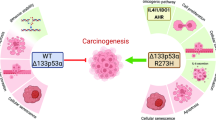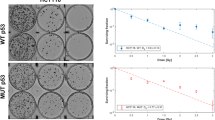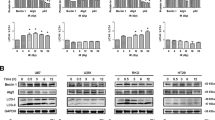Abstract
The tumour suppressor gene, p53, and genes coding for positive signal transduction factors can influence transit through cell-cycle checkpoints and modulate radiosensitivity. Here we examine the effects of RAF1 protein on the rate of exit from a G2/M block induced by γ-irradiation in relation to intrinsic cellular radiosensitivity in human cell lines expressing wild-type p53 (wtp53) protein as compared to mutant p53 (mutp53) protein. Cell lines which expressed mutp53 protein were all relatively radioresistant and exhibited no relationship between RAF1 protein and cellular radiosensitivity. Cell lines expressing wtp53 protein, however, showed a strong relationship between RAF1 protein levels and the radiosensitivity parameter SF2. In addition, when post-irradiation perturbation of G2/M transit was compared using the parameter T50 (time after the peak of G2/M delay at which 50% of the cells had exited from a block induced by 2 Gy of irradiation), RAF1 was related to T50 in wtp53, but not mutp53, cell lines. Cell lines which expressed wtp53 protein and high levels of RAF1 had shorter T50s and were also more radiosensitive. These results suggest a cooperative role for wtp53 and RAF1 protein in determining cellular radiosensitivity in human cells, which involves control of the G2/M checkpoint. © 2000 Cancer Research Campaign
Similar content being viewed by others
Article PDF
Change history
16 November 2011
This paper was modified 12 months after initial publication to switch to Creative Commons licence terms, as noted at publication
References
Aloni-Grinstein R, Schwartz D and Rotter V (1995) Accumulation of wild-type p53 protein upon γ-irradiation induces a G2 arrest-dependent immunoglobulin κ light in chain gene expression. EMBO J 7: 1392–1401
Barraclough R, Kimbell R and Rudland PS (1987) Differential control of mRNA levels for Thy-1 antigen and laminin in rat mammary epithelial and myoepithelial-like cells. J Cell Physiol 131: 340–393
Bischoff JR, Casso D and Beach D (1992) Human p53 inhibits growth in Schizo saccharomyces pombe. Mol Cell Biol 12: 1405–1411
Blagosklonny MV, Schulte TW, Nguyen P, Mimnaugh EG, Trepel J and Neckers L (1995) Taxol induction of p21WAFI and p53 requires c-raf-1. Cancer Res 55: 4623–4626
Bristow RG, Jang A, Peacock J, Chung S, Benchimol S and Hill RP (1994) Mutant p53 increases radioresistance in rat embryo fibroblasts simultaneously transfected with HPV16-E7 and/or activated H-ras. Oncogene 9: 1527–1536
Bristow RG, Benchimol S and Hill RP (1996) The p53 gene as a modifier of intrinsic radiosensitivity: implications for radiotherapy. Radiother Oncol 40: 197–223
Browning PGW (1996) Proto-oncogene expression and intrinsic cellular radiosensitivity. PhD dissertation. The University of Liverpool: Liverpool, UK,
Carbone D, Chiba I and Mitsudomi T (1991) Polymorphism at codon 213 within the p53 gene. Oncogene 6: 1691–1692
Chirgwin JM, Przybyla AE, MacDonald RJ and Rutter WJ (1979) Isolation of biologically active ribonucleic acid from sources enriched in ribonuclease. Biochemistry 18: 5294–5299
Deacon J, Peckham MJ and Steel GG (1984) The radioresponsiveness of human tumours and the initial slope of the cell survival curve. Radiother Oncol 2: 317–323
de Fromentel C and Soussi T (1992) TP53 tumour suppressor gene – a model for investigating human mutagenesis. Genes Chromosomes Cancer 4: 1–15
Fan S, el Deiry WS, Bae I, Freeman J, Jondle D, Bhatia K, Fornace AJ Jr, Magrath I, Kohn KW and O’Connor PM (1994) p53 gene mutations are associated with decreased sensitivity of human lymphoma cells to DNA damaging agents. Cancer Res 54: 5824–5830
Fertil B and Malaise EP (1981) Inherent cellular radiosensitivity as a basic concept for human tumor radiotherapy. Int J Radiat Oncol Biol Phys 7: 621–629
FitzGerald TJ, Henault S, Sakakeeny M, Santucci MA, Pierce JH, Anklesaria P, Kase K, Das I and Greenberger JS (1990) Expression of transfected recombinant oncogenes increase radiation resistance of clonal hematopoietic and fibroblast cell lines selectively at clinical low dose rate. Radiat Res 122: 44–52
Guillouf C, Rosselli F, Krishnaraju K, Moustacchi E, Hoffman B and Liebermann DA (1995) p53 involvement in control of G2 exit of the cell cycle: role in DNA damage-induced apoptosis. Oncogene 10: 2263–2270
Hollstein M, Sidransky D, Vogelstein B and Harris C (1991) p53 mutations in human cancers. Science 253: 49–53
Iliakis G, Metzger L, Muschel RJ and McKenna WG (1990) Induction and reapir of double strand breaks in radiation-resistant cells obtained by transformation of primary rat embryo cells with the oncogenes H-ras and v-myc. Cancer Res 50: 6575–6579
Jamal S and Ziff EB (1995) Raf phosphorylates p53 in vitro and potentiates p53-dependent transcriptional transactivation in vivo. Oncogene 10: 2095–2101
Kasid U, Pfeifer A, Weichselbaum RR, Dritschilo A and Mark GE (1987) The raf oncogene is associated with a radiation-resistant human laryngeal cancer. Science 237: 1039–1041
Kasid U, Pfeifer A, Brennan T, Beckett M, Weichselbaum RR, Dritschilo A and Mark GE (1989) Effect of antisense c-raf-1 on tumorigenicity and radiation sensitivity of a human squamous carcinoma. Science 243: 1354–1356
Kastan MB, Onyekwere O, Sidransky D, Vogelstein B and Craig RW (1991) Participation of p53 protein in the cellular response to DNA damage. Cancer Res 51: 6304–6311
Kastan MB, Zhan Q, el-Deiry WS, Carrier F, Jacks T, Walsh WV, Plunkett BS, Vogelstein B and Fornace AJ Jr (1992) A mammalian cell cycle checkpoint pathway utilising p53 and GADD45 is defective in ataxia-telangiectasia. Cell 71: 587–597
Kawashima K, Mihara K, Usuki H, Shimizu N and Namba M (1995) Transfected mutant p53 gene increases X-ray-induced cell killing and mutation in human fibroblasts immortalized with 4-nitroquinoline 1-oxide but does not induce neoplastic transformation of the cells. Int J Cancer 61: 76–79
Kelland LR, Edwards SM and Steel GG (1988) Induction and rejoining of DNA double-strand breaks in human cervix carcinoma cell lines of differing radiosensitivity. Radiat Res 116: 526–538
Khanna KK and Lavin MF (1993) Ionizing radiation and UV induction of p53 protein by different pathways in ataxia-telangiectasia cells. Oncogene 8: 3307–3312
Lee JM and Bernstein A (1993) p53 mutations increase resistance to ionizing radiation. Proc Natl Acad Sci USA 90: 5742–5746
Lees Miller SP, Sakaguchi K, Ullrich SJ, Appella E and Anderson CW (1992) Human DNA-activated protein kinase phosphorylates serines 15 and 37 in the amino-terminal transaction domain of human p53. Mol Cell Biol 12: 5041–5049
Lovric J and Moelling K (1996) Activation of Mil/Raf protein kinases in mitotic cells. Oncogene 12: 1109–1116
Mazars GR, Jeanteur P, Lynch HT, Lenoir G and Theillet C (1992) Nucleotide sequence polymorphism in a hotspot mutation region of the p53 gene. Oncogene 7: 781–782
McIlwrath AJ, Vasey PA, Ross GM and Brown R (1994) Cell cycle arrests and radiosensitivity of human tumor cell lines: dependence on wild-type p53 for radiosensitivity. Cancer Res 54: 3718–3722
McIntyre JF, Smith-Sorensen B, Friend SH, Kassell J, Borrensen AL, Yan YX, Russo C, Sato J, Barbier N, Miser J, Malkin D and Gebhardt MC (1994) Germline mutations of p53 tumour suppressor gene in children with osteosarcoma. J Clin Oncol 12: 925–930
McKenna WG, Weiss MC, Endlich B, Ling CC, Bakanauskas VJ, Kelsten ML and Muschel RJ (1990) Synergistic effect of the v-myc oncogene with H-ras on radioresistance. Cancer Res 50: 97–102
McKenna WG, Iliakis MC, Weiss EJ, Bernhard EJ and Muschel RJ (1991) Increased G2 delay in radiation-resistant cells obtained by transformation of primary rat embryo cells with the oncogenes H-ras and v-myc. Radiat Res 125: 283–287
Midgley CA and Lane DP (1997) p53 protein stability in tumour cells is not determined by mutation but is dependent on Mdm2 binding. Oncogene 15: 1179–1189
Milne DM, Palmer RH and Meek DW (1992) Mutation of the casein kinase II phophorylation site absolishes the anti-proliferative activity of p53. Nucleic Acids Res 20: 5565–5570
Milne DM, Campbell DG, Caudwell FB and Meek DW (1994) Phosphorylation of the tumour suppressor protein p53 by mitogen activated protein kinases. J Biol Chem 269: 9253–9260
Nunez MI, Villalobos M, Olea N, Valenzuela MT, Pedraza V, McMillan TJ and Ruiz de Almodovar JM (1995) Radiation-induced DNA double-strand break rejoining in human tumour cells. Br J Cancer 71: 311–316
Pardo FS, Su M, Borek C, Preffer F, Dombkowski D, Gerweck L and Schmidt EV (1994) Transfection of rat embryo cells with mutant p53 increases the intrinsic radiation resistance. Radiat Res 140: 180–185
Paules RS, Levedakou EN, Wilson SJ, Innes CL, Rhodes N, Tlsty TD, Galloway DA, Donehower LA, Tainsky MA and Kaufmann WK (1995) Defective G2 checkpoint function in cells from individuals with familial cancer syndromes. Cancer Res 55: 1763–1773
Pirollo KF, Garner R, Yuan SY, Li L, Blattner WA and Chang EH (1989) raf involvement in the simultaneous genetic transfer of the radioresistant and transforming phenotypes. Int J Radiat Biol 55: 783–796
Pirollo KF, Tang YA, Villegas Z, Chen Y and Chang EH (1993) Oncogene-transformed NIH 3T3 cells display radiation resistance levels indicative of a signal transduction pathway leading to the radiation-resistant phenotype. Radiat Res 135: 234–243
Powell SN and McMillan TJ (1994) The repair fidelity of restriction enzyme-induced double strand breaks in plasmid DNA correlates with radioresistance in human tumor cell lines. Int J Radiat Oncol Biol Phys 29: 1035–1040
Radford IR (1994) p53 status, DNA double-strand break repair proficiency and radiation response of mouse lymphoid and myeloid cell lines. Int J Radiat Biol 66: 557–560
Rodrigues NR, Rowan A, Smith MEF, Kerr IB, Bodmer WF, Gannon JV and Lane DP (1990) p53 mutations in colorectal cancer. Proc Natl Acad Sci USA 87: 7555–7559
Rosselli F, Ridet A, Soussi T, Duchaud E, Alapetite C and Moustacchi E (1995) p53-dependent pathway of radio-induced apoptosis is altered in Fanconi anemia. Oncogene 10: 9–17
Sanger F, Nicklen S and Coulson AR (1997) DNA sequencing with chain terminating inhibitors. Proc Natl Acad Sci USA 74: 5463–5467
Segawa K, Hokuto J, Minowa A, Okyama K and Takano T (1993) Cyclin E enhances p53 mediated transactivation. FEBS Lett 329: 283–286
Schwartz JL, Mustafi R, Beckett MA, Gzyzewski EA, Farhangi E, Grdina DJ, Rotmensch J and Weichselbaum RR (1991) Radiation-induced DNA double-strand break frequencies in human squamous cell carcinoma cell lines of different radiation sensitivities. Int J Radiat Biol 59: 1314–1352
Schwartz D, Almog N, Peled A, Goldfinger N and Rotter V (1997) Role of wild type p53 in the G2 phase: regulation of the γ-irradiation-induced delay and DNA repair. Oncogene 15: 2597–2607
Shimm DS, Miller PR, Lin T, Moulinier PP and Hill AB (1992) Effects of v-src oncogene activated on radiation sensitivity in drug-sensitive and in multidrug-resistant rat fibroblasts. Radiat Res 129: 149–156
Siles E, Villalobos M, Valenzuela MT, Nunez MI, Gordon A, McMillan TJ, Pedraza V and Ruiz de Almodovar JM (1996) Relationship between p53 status and radiosensitivity in human tumour cell lines. Br J Cancer 73: 581–588
Siliciano JD, Canman C, Taya Y, Sakaguchi K, Appella E and Kastan MB (1998) DNA damage induces phosphorylation of the amino-terminus of p53. Proc 89th AACR 77: 527(abst)
Stewart N, Hicks GG, Paraskevas F and Mowat M (1995) Evidence for a second cell cycle block at G2/M by p53. Oncogene 10: 109–115
Storey A, Thomas M, Kalita A, Harwood C, Gardiol D, Mantovani F, Breuer J, Leigh IM, Matlashewski G and Banks L (1998) Role of a p53 polymorphism in the development of human papilloma-virus-associated cancer. Nature 393: 229–234
Su LN and Little JB (1993) Prolonged cell cycle delay in radioresistant human cell lines transfected with activated ras oncogene and/or simian virus 40 T-antigen. Radiat Res 133: 73–79
Suzuki K, Watanabe M and Miyoshi J (1992) Differences in effects of oncogenes on resistance of gamma rays, ultraviolet light and heat shock. Radiat Res 129: 157–162
Tada M, Matsumoto R, Iggo RD, Onimaru R, Shirato H & Sawamuraand Shinohe Y (1998) Selective sensitivity to radiation of cerebral glioblastomas harboring p53 mutations. Cancer Res 58: 1793–1797
Takahashi T, Suzuki H, Hida T, Sekido Y, Ariyoshi Y and Heda R (1991) The p53 gene is very frequently mutated in small-cell lung cancer with a distinct nucleotide substitution pattern. Oncogene 6: 1775–1778
Warenius HM, Browning PG, Britten RA, Peacock JA and Rapp UR (1994) C-raf-1 proto-oncogene expression relates to radiosensitivity rather than radioresistance. Eur J Cancer 30A: 369–375
Warenius HM, Jones MD and Thompson CCM (1996) Exit from G2 phase after 2Gy gamma irradiation is faster in radiosensitive human cells with high expression of the RAF-1 proto-oncogene. Radiat Res 146: 485–493
Whitaker SJ, Ung TC and McMillan TJ (1995) DNA double strand break induction and rejoining as determinants of human tumour cell radiosensitivity. A pulsed-field gel electrophoresis study. Int J Radiat Biol 67: 7–18
Xia F, Wang X, Wang YH, Tsang NM, Yandell DW, Kelsey KT and Liber HL (1995) Altered p53 status correlates with differences in sensitivity to radiation-induced mutation and apoptosis in two closely related human lymphoblast lines. Cancer Res 55: 12–15
Zhen W, Denault CM, Loviscek K, Walter S, Geng L and Vaughan AT (1995) The relative radiosensitivity of TK6 and W1-L2-NS lymphoblastoid cells derived from a common source is primarily determined by their p53 mutational status. Mutat Res 346: 85–92
Author information
Authors and Affiliations
Rights and permissions
From twelve months after its original publication, this work is licensed under the Creative Commons Attribution-NonCommercial-Share Alike 3.0 Unported License. To view a copy of this license, visit http://creativecommons.org/licenses/by-nc-sa/3.0/
About this article
Cite this article
Warenius, H., Jones, M., Gorman, T. et al. Combined RAF1 protein expression and p53 mutational status provides a strong predictor of cellular radiosensitivity. Br J Cancer 83, 1084–1095 (2000). https://doi.org/10.1054/bjoc.2000.1409
Received:
Revised:
Accepted:
Published:
Issue date:
DOI: https://doi.org/10.1054/bjoc.2000.1409
Keywords
This article is cited by
-
The UBC-40 Urothelial Bladder Cancer cell line index: a genomic resource for functional studies
BMC Genomics (2015)
-
Enhanced induction of apoptosis in a radio-resistant bladder tumor cell line by combined treatments with X-rays and wortmannin
Radiation and Environmental Biophysics (2008)



